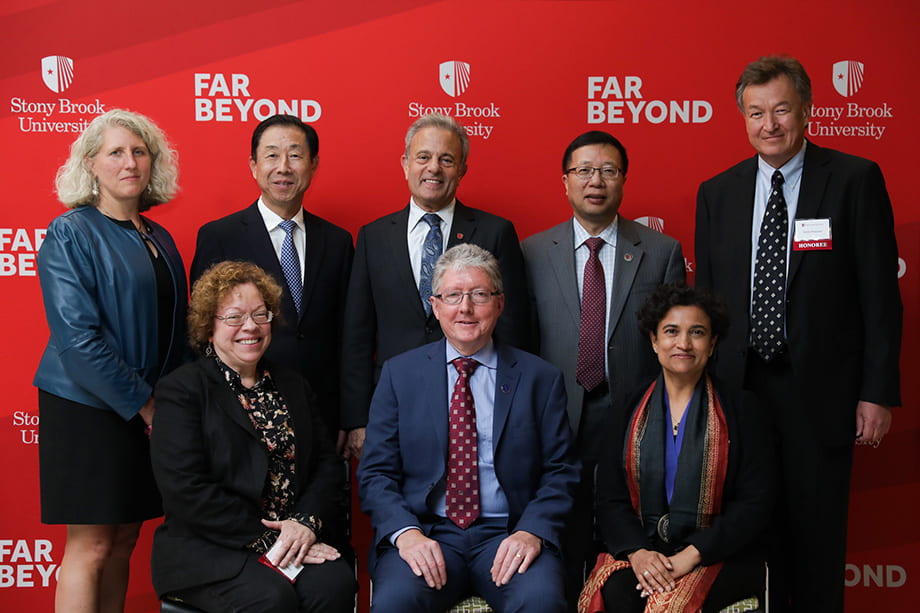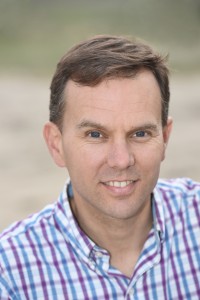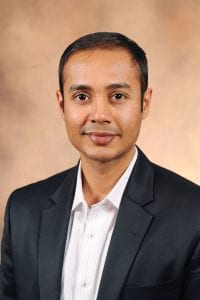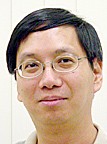Photo above: the 2019 class of SUNY Chancellor’s Award recipients, including SoMAS Adjunct Lecturer Maria Brown.
Congratulations to SoMAS faculty and staff for their recent awards and recognitions.
Interim President Michael Bernstein honored more than 65 faculty and staff at the Annual Awards and Recognition Dinner on October 3, 2019. Dr. Bernstein, joined by Interim Provost Minghua Zhang, celebrated recent faculty achievements, appointments to distinguished professorships and Chancellor’s Awards recipients.

Stony Brook University Interim President Michael Bernstein with new Distinguished Professors, including Interim Provost and SoMAS Professor Minghua Zhang.
“As a young institution, our rise to excellence has been rapid. We started as a teacher’s college in 1957, eventually evolving to an R-1 university and becoming a member of the AAU by 2001,” said Bernstein as he began his remarks. “How did we transform into an AAU institution in a matter of decades? We excelled in key metrics: doctoral education, program impact and faculty quality.
“Our faculty and staff continue to set the standard of excellence at our University,” Bernstein continued, telling the awardees that “your legacy at Stony Brook is defined by much more than these awards and recognitions. It is marked indelibly by the imprint you leave on our next generation of leaders. We are fortunate to have you as educators and mentors at our institution.”
Congratulations to this year’s honorees from SoMAS:
Chancellor’s Awards for Excellence
Adjunct Teaching: Maria Brown
Faculty Achievements
- Steven Beaupré, CFAMS/Robert Schneider Prize
- Lee Koppelman, Dedication of the Preserve by Town of Brookhaven
- Minghua Zhang, Distinguished Professor
For a complete list of all faculty achievements and Chancellor’s Awards received by Stony Brook faculty and staff through the years, please visit stonybrook.edu/provost/faculty/awards/.
Professor Chris Gobler and co-PIs Arjun Venkatesan and Xinwei Mao from the NYS Center for Clean Water Technology have a new award from the NYS Department of Health, in support of the project “Programming to Address Emerging Contaminants in Drinking Water”, in the amount $3,000,000, for the period 8/1/2019 – 7/31/2024. The Project Summary is provided below.
 The State University of New York at Stony Brook has established the New York State Center for Clean Water Technology (“Center”). The program funded by this agreement will focus on developing and evaluating methods to remove organic compounds from drinking water supplies, with the next focus on perfluoroalkyl substances (PFAS). This agreement represents the second phase of the State-sponsored, multi-year program to proactively address emerging contaminants in drinking water.
The State University of New York at Stony Brook has established the New York State Center for Clean Water Technology (“Center”). The program funded by this agreement will focus on developing and evaluating methods to remove organic compounds from drinking water supplies, with the next focus on perfluoroalkyl substances (PFAS). This agreement represents the second phase of the State-sponsored, multi-year program to proactively address emerging contaminants in drinking water.
The second-phase has five objectives: (1) evaluating the efficiency of existing treatment methods (GAC, ion-exchange treatment, advanced oxidation processes) in removing PFOS, PFOA and more specifically, short-chain PFAS; (2) research and development of novel or refined treatment technologies (novel sorbents and/or combination of technologies) to enhance the removal of short-chain PFASs from drinking water; (3) scale-up, build and test the feasibility of select novel/refined treatment technologies for pilot-scale treatment (point-of-entry) of contaminated drinking water; (4) perform follow-up research as needed to address emerging concerns related to PFAS in drinking water (e.g. expand the Center’s in-house instrumentation capabilities to monitor compounds (e.g. GenX, ADONA etc.) not included in the U.S. EPA modified Method 537); and (5) continuation of current 1,4-dioxane research and oversight of 1,4-dioxane pilot grant program.
 Dr. Arjun Venkatesan, Associate Director for Drinking Water Initiatives at the NYS Center for Clean Water Technology, has received a new grant from DOE, in support of the project “Application of Electron Beam-Technology to Decompose Persistent Emerging Drinking Water Contaminants: Poly- and Perfluoroalkyl Substances (PFAS) and 1, 4-Dioxane” in the amount $224,000, for the period 9/25/2019 – 9/24/2020. The project abstract is provided below.
Dr. Arjun Venkatesan, Associate Director for Drinking Water Initiatives at the NYS Center for Clean Water Technology, has received a new grant from DOE, in support of the project “Application of Electron Beam-Technology to Decompose Persistent Emerging Drinking Water Contaminants: Poly- and Perfluoroalkyl Substances (PFAS) and 1, 4-Dioxane” in the amount $224,000, for the period 9/25/2019 – 9/24/2020. The project abstract is provided below.
Poly- and perfluoroalkyl substances (PFAS) and 1,4-dioxane (1,4-D) are persistent emerging contaminants (ECs) that are currently under consideration for federal and state-specific regulations in drinking water. Both PFAS and 1,4-D are highly resistant to degradation and are not effectively removed by conventional drinking water treatment systems. Results from the Unregulated Contaminant Monitoring Rule (UCMR) 3 survey showed that >540 sites across the nation are contaminated with both PFAS and 1,4-D. The water providers are tasked with upgrading their treatment systems to address both these contaminants to meet upcoming regulatory standards. Hence, there is a need to identify technologies that can effectively remove both these contaminants. Water treatment via electron beam (e-beam) has been proven effective at treating a wide range of contaminants, including perfluorooctane sulfonate (PFOS), perfluorooctanoic acid (PFOA), polychlorinated biphenyls, and trichloroethylene. While the e-beam process is often considered similar to advanced oxidation processes (AOPs), e-beam technology is unique in that it produces both highly oxidizing and reducing species at the same time. E-beam has not seen wide spread adoption because of operating costs and inability to treat large flow rates. The Illinois Accelerator Research Center at the DOE’s Fermilab is developing a novel e-beam accelerator that will be cheaper to operate than conventional e-beam technologies, treat greater flow rates and be compact enough so that it is portable.
We hypothesize that e-beam technology can decompose both PFAS and 1,4-dioxane from drinking waters simultaneously. The specific objectives of the proposed study are as follows: (i) to determine the effectiveness of 9 MeV electrons provided by the Fermilab’s Accelerator Application Development and Demonstration (A2D2) tool to decompose PFAS and 1,4-D; (ii) to determine if the process causes the formation of other hazardous byproducts during water treatment; (iii) to apply the optimized treatment to field (surface and ground) water samples from the DOE and DOD sites contaminated with PFAS and 1,4-D, and; (iv) to assess the economic feasibility based on energy demands for large-scale water treatment applications. Results from the proposed work will provide the very first demonstration of the effectiveness of e-beam technology to decompose environmentally relevant levels of PFAS and 1,4-D in water. To the best of our knowledge, the effectiveness of e-beam to degrade 1,4-D has not been studied in the past. Existing technologies, such as granular activated carbon (GAC) filters and reverse osmosis (RO) systems do not degrade PFAS, but rather concentrate them either by adsorption (GAC) or membrane rejection (RO). The proposed e-beam application can provide opportunities to completely degrade these persistent and toxic chemicals from contaminated waters and additionally may be utilized to treat concentrated process flows resulting from other water treatment applications (e.g. RO rejects). Successful demonstration of a cost-effective e-beam treatment approach through the proposed research will enable the implementation of the technology for large-scale water treatment applications.
Professor Edmund Chang has received a new grant from NOAA, in support of the project “Understanding and Quantifying Uncertainties Related to Counteracting Influence of Projected Reduction in Temperature Gradient and Increase in Atmospheric Moisture on Winter Storms and Flooding”, in the amount $199,843, for the period 9/1/2019 – 8/31/2021. The project abstract is provided below.
During the cool season, winter storms and inland flooding brought by extratropical cyclones lead to substantial losses in life and property each year, accounting for many of the billion-dollar weather and climate disasters that have plagued the U.S. How these extremes may change under global warming is still uncertain, due to the counteracting influence of increase in atmospheric moisture due to warming, and the reduction in pole-to-equator temperature gradient due to enhanced high latitude warming. In this project, an integrated assessment on the multiple physical processes that can impact these extremes will be conducted to understand and quantify the uncertainties of these projections. The proposed studies will make use of the high resolution global multi-model ensemble projections, a novel dataset that will become available from the Coupled Model Intercomparison Project Phase 6 (CMIP6), as well as the innovative diagnostic tools and metrics relating cyclone activity to weather extremes recently developed by the PI’s research group.
As the planet warms under increased CO2 radiative forcing, Northern Hemisphere Polar regions are warming faster than the global average, thus reducing the meridional temperature gradient in the Northern Hemisphere, leading to weaker dynamical forcing for the extratropical cyclones that cause weather extremes such as winter storms and cool season precipitation extremes. However, increased moisture under warming can lead to increased latent heat release within these storms, potentially enhancing their intensity. Recent studies have suggested that previous generations of Global Climate Models (GCMs) may not have sufficient resolution to correctly simulate the interactions between diabatic heating and storm dynamics, potentially under-estimating the intensity of these storms in future projections. CMIP6 will provide, for the first time, multi-model ensemble projections at a resolution high enough (about 25 km grid spacing) to resolve these interactions. Over the past few years, the PI’s research group has developed innovative process oriented diagnostics and metrics that quantitatively relate cyclone variability and change to those of the weather extremes that these cyclones can cause, and can thus make full use of these novel high resolution CMIP6 projections to conduct a process oriented, integrated assessment of the uncertainties in the projected changes of these extremes associated with the uncertainties in the underlying thermodynamical and dynamical processes.
This project is highly relevant to NOAA’s objective of providing the essential and highest quality environmental information vital to our Nation’s safety, prosperity and resilience. This proposal also directly responds to the Climate Program Office MAPP Program’s call for building on CMIP6 results for improved depictions of 21st Century climate over the United States, by developing integrated projections on how winter storms and cool season precipitation extremes that adversely impact multiple regions of the U.S., as well as developing integrated process-level understanding of these projected changes for the purpose of characterizing associated uncertainties by relating these weather and climate extremes to the physical processes that generate them.
Professor Marat Khairoutdinov has a new award from Brookhaven National Laboratory in support of the project “Integrating high resolution models and observations for urban science applications”, with an award amount of $23,212 for the project period August 1, 2019 – July 31, 2020.

The System Atmospheric Modeling (SAM) model will be applied over a domain off the US East Coast to examine the sensitivity of offshore wind patterns to atmospheric stability and oceanic surface fluxes. The simulations will provide guidance for the placement and operation of wind turbines to maximize efficiency in renewable energy production. A high-resolution simulation including diurnal variation of winds and their drivers will improve understanding of this geographical region which has been identified for development of offshore wind facilities. This work will be useful in responding to expected funding opportunities (DOE and State of New York) in the near future.
The PI will begin to refine an existing model to simulate a point source release in Manhattan to better understand transport of pollutant and/or contaminants in the urban environment. The atmospheric boundary layer in this environment is complex and may vary appreciably depending on specific conditions at any given time. The model is currently configured to run during the nighttime. This work would extend the simulations to day time taking in to account solar heating in the city. This work will contribute to on-going research within CMAS and upcoming field campaigns in New York City to improve predictions of dispersion and circulation patterns within the city.
 Dr. Roy Price has received word that his proposal to the NASA Habitable Worlds program has been funded! The title of the project is “Habitability of saponite-rich hydrothermal systems of early Mars.”
Dr. Roy Price has received word that his proposal to the NASA Habitable Worlds program has been funded! The title of the project is “Habitability of saponite-rich hydrothermal systems of early Mars.”
Other Faculty Research Project News
21-Year CARIACO Ocean Time Series Ends: That’s a Wrap! ¡Fin del Día!
Award-Winning Program, led by scientists in Venezuela & the U.S., leaves a rich 21-yr legacy – and perhaps a few tears
 Written by Kristen Kusek, Science Communication Strategist for USF CMS
Written by Kristen Kusek, Science Communication Strategist for USF CMS
From November 1995 to January 2017, the CARIACO Ocean Time Series program has been studying the relationship between surface primary production (carbon fixation rates by photosynthesis of planktonic algae), regional hydrography, physical forcing variables (such as the wind), and the settling flux of particulate organic carbon in the Cariaco Basin. This tectonic depression, located on the continental shelf of Venezuela, shows marked seasonal and interannual variation in hydrography and primary production induced in part by the regular migration of the Intertropical Convergence Zone (ITCZ). SoMAS faculty Mary Scranton and Gordon Taylor have been part of the project with colleagues from the Fundación La Salle de Ciencias Naturales, Estación de Investigaciones Marinas de Margarita in the Isla de Margarita, Venezuela, the Laboratorio de Sensores Remotos/Universidad Simón Bolívar at the Instituto Venezolano de Investigaciones Científicas (IVIC), the Universidad de Oriente, Núcleo Sucre and Nueva Esparta in Cumana and Margarita, Venezuela, the University of South Florida Institute for Marine Remote Sensing and Oceanic Nutrient Laboratory, and the University of South Carolina, Department of Geological Sciences in Columbia, SC.
A recent article highlights the “Scientific Legacy of the Program.”





